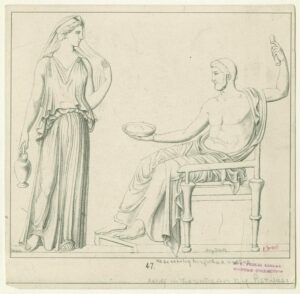
Ivory-armed Hera smiled at this, and as she smiled she took the cup from
her son’s hands. Then Hephaistos drew sweet nectar from the mixing-bowl, and
served it round among the gods, going from left to right; and the blessed
gods laughed out a loud approval,[1]
According to mythology ambrosia is a food of the gods, thus named because
it is ‘a-brotos,’ not for mortals to eat, and the ‘m’ was inserted in the
middle, in the Aeolic fashion. Now the drink of the gods is called nectar,
from ‘ne’ the negative particle, and ‘kto’ which means “to kill,” so
‘nectar’ is the drink of those who cannot be killed. This, therefore, is the
original meaning of nectar.[2]
Homer says too that ambrosia and nectar are the food and drink of the gods
as demonstrated by Calypso in the Odyssey Book 5. But, where did the food
of the gods come from? What was ambrosia and nectar? And when did it enter
the mythological timeline? To my surprise I could not find an answer in
Ancient Greek literature.
Where? As matter of fact the earliest answer I found as to where it came
from was by Alexander Stuart Murray in 1873:
We are told that the (Great River) ocean encircled the earth with a great
stream and was a region of wonders of all kinds; that (the god) Oceanus
lives there with his wife (the goddess) Tethys; that there were the islands
of blest, the gardens of the gods, the sources of the nectar and ambrosia on
which the gods lived.[3]
The only other references I found were by Aaron Atsma: “The gods feasted on
ambrosia and nectar, substances collected from the meadows of the
earth-encircling river Okeanos.”[4]
So that is two very late sources which agree that ambrosia and nectar came
from the Isles of the Blest wafted by “the high-singing breezes of the
west.” Does anyone know an earlier reference to where ambrosia and nectar
come from?
What? As to what ambrosia and nectar were, only Robert Graves had opinions.
According to Robert Graves in 1955, “Mead was ‘nectar’, brewed from fermented
honey,”[5] and that “ambrosia, the delectable food of the gods, seems to have
been a porridge of barley, oil and chopped fruit.”[6] Later in his most famous
book he gave a slightly different version of the menu.[7] However in the 1960
foreword of the second edition Graves had second thoughts about nectar and
ambrosia; wine or ivy-ale and raw mushrooms amanita muscaria. Does anyone
have an earlier mention as to what ambrosia and nectar were?
When? But when did it come to be the exclusive food of the Olympian gods?
The first answer I found was by Sir James George Frazer in 1926 regarding
the rebellion of Zeus: “Zeus made his father Cronus drunk with honey-wine
and bound him fast.”[8]
In other words, ambrosia and nectar came into the Greek mythic timeline with
Zeus’s accession. And by implication the Titans fell from power because
they still drank wine. Robert Graves seems to agree:
Zeus grew to manhood among the shepherds of Ida, occupying another cave;
then sought out Metis the Titaness, who lived beside the Ocean stream. On
her advice he visited his mother Rhea, and asked to be made Cronus’s
cup-bearer. Rhea readily assisted him in his task of vengeance; she provided
the emetic potion, which Metis had told him to mix with Cronus’s honeyed
drink. Cronus, having drunk deep, vomited up first the stone, and then
Zeus’s elder brothers and sisters.[9]
Aaron Atsma also reports a wine-drinking Cronus:
When Zeus was grown up enough, he became his father’s cupbearer without his
true identity being discovered. With help from Metis, who would later become
the first wife of Zeus, he was able to give his father a mixture of mustard
and wine, which caused Cronus to throw up his swallowed children one by one.
When all of his siblings were freed, Zeus gathered them and was able to
convince them to start a rebellion against Cronus.[10]
So there is the answer, ambrosia and nectar are found on the zephyr-swept
shores of the Great River Ocean, Graves (and no one else) had ideas about
what it was and it appeared in Hesiod’s storyline soon enough to ensure
Zeus’s victory. Any other sources as to where it came from, what it was,
and when it first appeared in the timeline would be appreciated.
Image Credits
The Miriam and Ira D. Wallach Division of Art, Prints and Photographs: Picture Collection, The New York Public Library. Hebe serving her father [Zeus] nectar. Retrieved from https://digitalcollections.nypl.org/items/510d47e4-37b0-a3d9-e040-e00a18064a99.